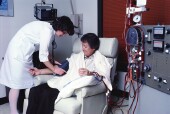- Skip Storing This Everyday Product in the Fridge Door
- Green Tea + B3 Pairing May Boost Brain Health
- Navigating Your Midlife Crisis: Embracing New Possibilities
- City Raccoons Showing Signs of Domestication
- Mapping the Exposome: Science Broadens Focus to Environmental Disease Triggers
- One Week Less on Social Media Linked to Better Mental Health
- Your Brain Changes in Stages as You Age, Study Finds
- Some Suicide Victims Show No Typical Warning Signs, Study Finds
- ByHeart Formula Faces Lawsuits After Babies Sickened With Botulism
- Switch to Vegan Diet Could Cut Your Greenhouse Gas Emissions in Half
Women Still Being Left Out of Medical Research: Report


Two decades after the passage of a landmark law mandating that women be represented in government-funded medical research, a new report reveals that the world of science is still ignoring women’s unique health issues far more than it should.
“The science that informs medicine routinely fails to consider the impact of sex and gender, and this occurs at some of the earliest stages of research — from animal to human studies,” said report author Dr. Paula Johnson. The new findings are scheduled for release Monday at a national summit on women’s health issues in Boston.
While women are now more routinely included in clinical trials and an entire field of women’s health has emerged beyond reproductive health, “there are still enormous gaps in the scientific process as it relates to women,” said Johnson, who is executive director of The Connors Center for Women’s Health at Brigham and Women’s Hospital in Boston.
The latest statistics are indeed grim:
- Less than one-third of cardiovascular clinical trial participants are women, and only one-third of trials that include women report sex-specific outcomes. Yet, cardiovascular disease is the number one cause of death among U.S. women.
- Less than 45 percent of animal studies on anxiety and depression use female animals, although depression is a leading cause of disease among women worldwide.
- Lung cancer researchers often fail to include an analysis of data by sex or gender-specific factors, despite the fact that lung cancer behaves differently in nonsmoking women than in nonsmoking men. This disease kills more women each year than breast, ovarian and uterine cancers combined.
- A woman’s overall lifetime risk of developing Alzheimer’s disease is almost twice that of a man, and it has been thought that this is simply because women live longer. However, hormones may play a role.
One expert explained the importance of including women in medical research.
“Unless you study the populations that you’re treating, you really don’t know how that population is going to respond,” said Dr. Lynn Gordon, associate dean of diversity affairs, at the David Geffen School of Medicine at the University of California, Los Angeles.
However, Gordon said, a lot of researchers don’t want to do studies on women of childbearing age due to their monthly hormonal fluctuations, for example.
“When you’re doing animal studies, you want to make things as standardized as possible,” she explained. “If you add in gender, how do you standardize, especially considering the hormone issues,” but that doesn’t excuse the disparity, Gordon noted.
Gordon said pregnancy and safety to unborn children are concerns, too. “Again, I’m not excusing it or saying it’s an appropriate reason, but it is a concern investigators have,” she pointed out.
Gordon added that more studies on the natural history of diseases in women could be conducted, too, because they only require following women, not exposing anyone to experimental therapy.
Johnson said there may be a need for more rigorous enforcement of the law. “The law’s scope may be too limited to address all the dynamics of the problem,” she said.
She called on political, scientific and business leaders to push efforts to apply sex differences to research.
“We really have to raise awareness,” Johnson said. “There’s an overall lack of awareness among our population.”
The report also recommends more transparency in research on drugs and medical devices, and suggests that clinical trials should carry a disclaimer if a study has not included enough female participants. Johnson said another goal is to adopt clinical care practices that use a gender-based lens in health care and medical research.
Women need to drive the conversation, said Dr. Eve Higginbotham, vice dean for diversity and inclusion at the Perelman School of Medicine at the University of Pennsylvania, in Philadelphia.
“We still have a lot of bias embedded in academic medicine, and certainly it comes down to the people actually doing the studies,” said Higginbotham. “Women are still struggling to get to the highest levels of academic medicine. In many cases, women are not the primary drivers in many of these studies.”
Higginbotham noted that the highest levels of academia in medical schools are still slim on women — women only represent 5 percent of medical professors in the United States.
“Change takes time, and it’s going to take a number of factors to drive that,” Higginbotham said. “Having the summit is a good first step in at least acknowledging the lack of progress that has been made and making people more aware.”
More information
Here is more information on the women’s health summit.
Source: HealthDay
Copyright © 2025 HealthDay. All rights reserved.










